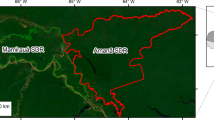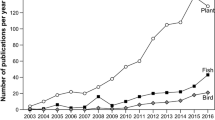Abstract
Although macrophyte–herbivore interactions in freshwater systems were generally disregarded for many years, recent data suggest that herbivory can be intense and important in structuring freshwater communities. This has led to the hypothesis that chemical defenses should be common among freshwater plants, but few studies have reported such chemical defenses, and no previous studies have assessed the frequency of chemical defenses among a substantial number of freshwater plant species. In a study of 21 macrophyte species co-occurring with the omnivorous crayfish Procambarus acutus in a southeastern USA wetland environment, we found that extracts of 11 species (52%) deterred feeding by P. acutus when tested in artificial foods at natural concentrations. Of these 11 chemically defended species, one species, Eupatorium capillifolium, consistently had a more unpalatable extract following mechanical damage to plant tissue, indicative of an activated chemical defense. Because herbivores are commonly nitrogen-limited and select food based on several plant traits, including plant nutritional value, it might be expected that chemical defenses would be especially important for protein-rich plants. However, we found no relationship between soluble protein concentration and deterrence of plant extracts.



Similar content being viewed by others
References
R. C. Bolser M. E. Hay (1998) ArticleTitleA field test of inducible resistance to specialist and generalist herbivores using the water lily Nuphar luteum Oecologia 116 143–153
R. C. Bolser M. E. Hay N. Lindquist W. Fenical D. Wilson (1998) ArticleTitleChemical defenses of freshwater macrophytes against crayfish herbivory J. Chem. Ecol. 24 1639–1658
M. M. Bradford (1976) ArticleTitleA rapid and sensitive method for the quantification of microgram quantities of protein utilizing the principle of protein-dye binding Anal. Biochem. 72 248–254
G. L. Cetrulo M. E. Hay (2000) ArticleTitleActivated chemical defenses in tropical versus temperate seaweeds Mar. Ecol., Prog. Ser. 207 243–253
E. E. Conn (1979) Cyanide and cyanogenic glycosides G. A. Rosenthal D. H. Janzen (Eds) Herbivores: Their Interactions with Secondary Plant Metabolites Academic Press New York 387–412
G. Cronin (1998) Influence of macrophyte structure, nutritive value, and chemistry on the feeding choices of a generalist crayfish E. Jeppesen Ma. Sondergaard Mo. Sondergaard K. Christoffersen (Eds) The Structuring Role of Submerged Macrophytes in Lakes Sringer-Verlag New York 307–317
G. Cronin M. E. Hay (1996) ArticleTitleSusceptibility to herbivores depends on recent history of both the plant and animal Ecology 77 1531–1543
G. Cronin D. M. Lodge M. E. Hay M. Miller A. M. Hill T. Horvath R. C. Bolser N. Lindquist M. Wahl (2002) ArticleTitleCrayfish feeding preference for freshwater macrophytes: The influence of plant structure and chemistry J. Crustac. Biol. 22 708–718
H. Cyr M. L. Pace (1993) ArticleTitleMagnitude and patterns of herbivory in aquatic and terrestrial ecosystems Nature 361 148–150
Fritz, R. S. and Simms, E. L. (eds.). 1992. Plant Resistance to Herbivores and Pathogens: Ecology, Evolution, and Genetics. University of Chicago Press, Chicago.
Godfrey, R. K. and Wooten, J. W. (eds.). 1979. Aquatic and Wetland Plants of Southeastern United States: Monocotyledons. University of Georgia Press, Athens.
Godfrey, R. K. and Wooten, J. W. (eds.). 1981. Aquatic and Wetland Plants of Southeastern United States: Dicotyledons. University of Georgia Press, Athens.
M. E. Hay W. Fenical (1988) ArticleTitleMarine plant–herbivore interactions: The ecology of chemical defense Annu. Rev. Ecolog. Syst. 19 111–145
H. H. Hobbs (1981) The Crayfishes of Georgia Smithsonian Institution Press Washington, DC
G. E. Hutchinson (1975) A Treatise on Limnology. III Wiley New York
V. Jung G. Pohnert (2001) ArticleTitleRapid wound-activated transformation of the green algal defensive metabolite caulerpenyne Tetrahedron 57 7169–7172
R. Karban I. T. Baldwin (Eds) (1997) Induced Responses to Herbivory University of Chicago Press Chicago
W. C. Kerfoot R. M. Newman Z. Hanscom (1998) ArticleTitleSnail reaction to watercress leaf tissues: Reinterpretation of a mutualistic ‘alarm’ hypothesis Freshw. Biol. 40 201–213
J. Kubanek W. Fenical M. E. Hay P. J. Brown N. Lindquist (2000) ArticleTitleTwo antifeedant lignans from the freshwater macrophyte Saururus cernuus Phytochemistry 54 281–287
J. Kubanek M. E. Hay P. J. Brown N. Lindquist W. Fenical (2001) ArticleTitleLignoid chemical defense in the freshwater macrophyte Saururus cernuus Chemoecology 11 1–8
D. M. Lodge J. G. Lorman (1987) ArticleTitleReductions in submerged macrophyte biomass and species richness by the crayfish Orconectes rusticus Can. J. Fish. Aquat. Sci. 44 591–597
D. M. Lodge G. Cronin E. Donk ParticleVan A. J. Froelich (1998) Impacts of herbivory on plant standing crop: Comparisons among biomes, between vascular and nonvascular, and among freshwater herbivore taxa E. Jeppesen Ma. Sondergaard Mo. Sondergaard K. Christoffersen (Eds) The Structuring Role of Submerged Macrophytes in Lakes Springer-Verlag New York 149–174
J. Lubchenco S. D. Gaines (1981) ArticleTitleA unified approach to marine plant–herbivore interactions. I. Populations and communities Annu. Rev. Ecolog. Syst. 12 405–437
Mattson, W. J., Jr. 1980. Herbivory in relation to plant nitrogen content. Annu. Rev. Ecolog. Syst. 1:119–161.
R. M. Newman W. C. Kerfoot Z. Hanscom (1990) ArticleTitleWatercress and amphipods: Potential chemical defense in a spring stream macrophyte J. Chem. Ecol. 16 245–259
R. M. Newman Z. Hanscom W. Kerfoot (1992) ArticleTitleThe watercress glucosinolate–myrosinase system: A feeding deterrent to caddisflies, snails, and amphipods Oecologia 92 1–7
R. M. Newman W. C. Kerfoot Z. Hanscom SuffixIII (1996) ArticleTitleWatercress allelochemical defends high-nitrogen foliage against consumption: Effects on freshwater invertebrate herbivores Ecology 77 2312–2323
V. J. Paul K. L. Alstyne ParticleVan (1992) ArticleTitleActivation of chemical defenses in the tropical green algae Halimeda spp J. Exp. Mar. Biol. Ecol. 160 191–203
G. A. Rosenthal M. R. Berembaum (1992) Herbivores: Their Interaction with Plant Secondary Metabolites, Vol. 1 and 2. EditionNumber2 Academic Press San Diego
R. F. Sokal F. J. Rohlf (1994) Biometry: The Principles and Practice of Statistics in Biological Research EditionNumber3 W.H. Freeman & Co. New York
K. L. Alstyne ParticleVan L. T. Houser (2003) ArticleTitleDimethylsulfide release during macroinvertebrate grazing and its role as an activated chemical defense Mar. Ecol. Prog. Ser. 250 175–181
D. M. Wilson W. Fenical M. E. Hay N. Lindquist R. C. Bolser (1999) ArticleTitleHabenariol, a freshwater feeding deterrent from the aquatic orchid Habenaria repens (Orchidaceae) Phytochemistry 50 1333–1336
Acknowledgments
This research was supported by an NSF IGERT fellowship to A.P. We thank A. Chequer and E. Prince for help with field collections, G. Stanton and J. Parker for crayfish identification, and Z. Hallinan, A. Horner, and T. Watt for initial idea development. Comments from M. Hay, J. Romeo, and two anonymous reviewers improved the manuscript.
Author information
Authors and Affiliations
Corresponding author
Rights and permissions
About this article
Cite this article
Prusak, A.C., O’Neal, J. & Kubanek, J. Prevalence of Chemical Defenses among Freshwater Plants. J Chem Ecol 31, 1145–1160 (2005). https://doi.org/10.1007/s10886-005-4253-1
Received:
Revised:
Accepted:
Published:
Issue Date:
DOI: https://doi.org/10.1007/s10886-005-4253-1




